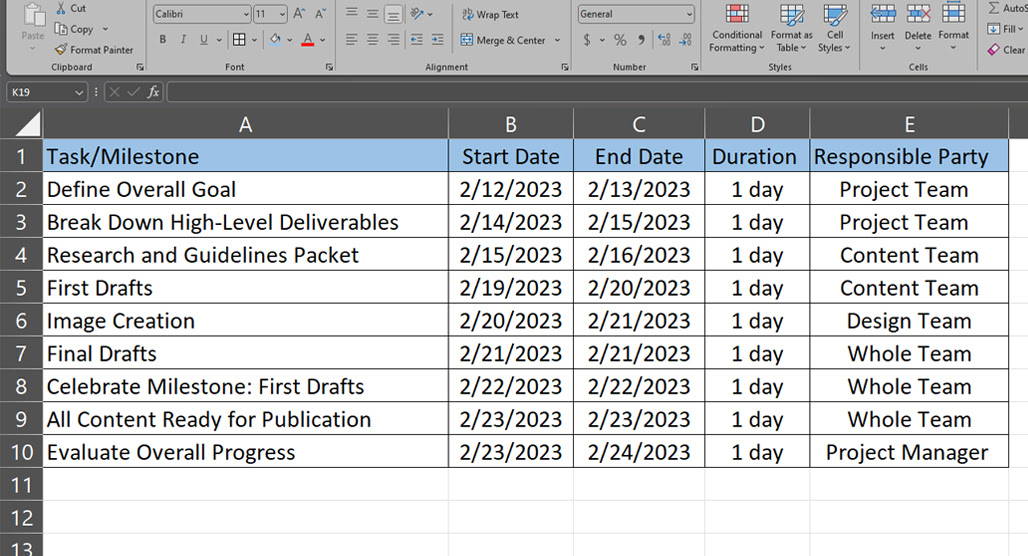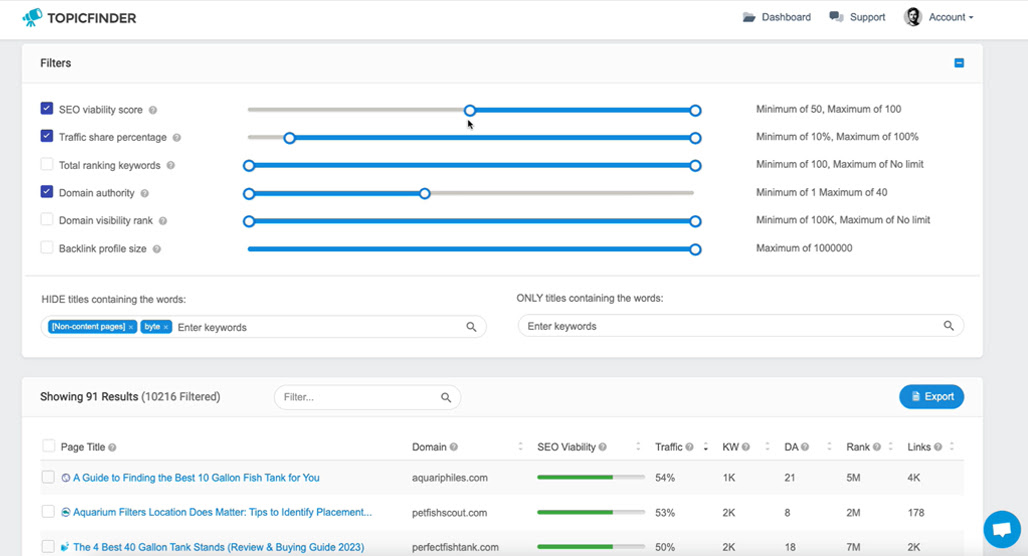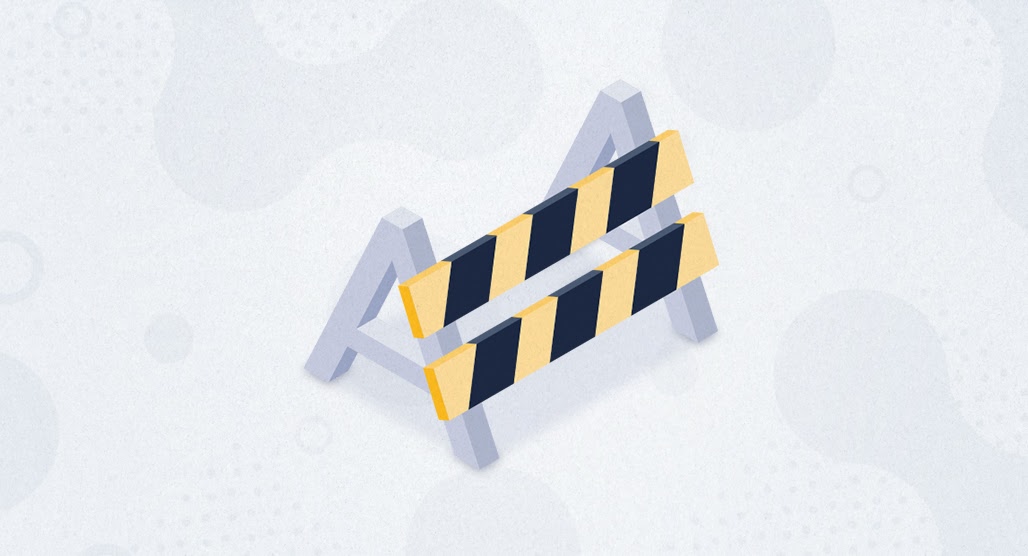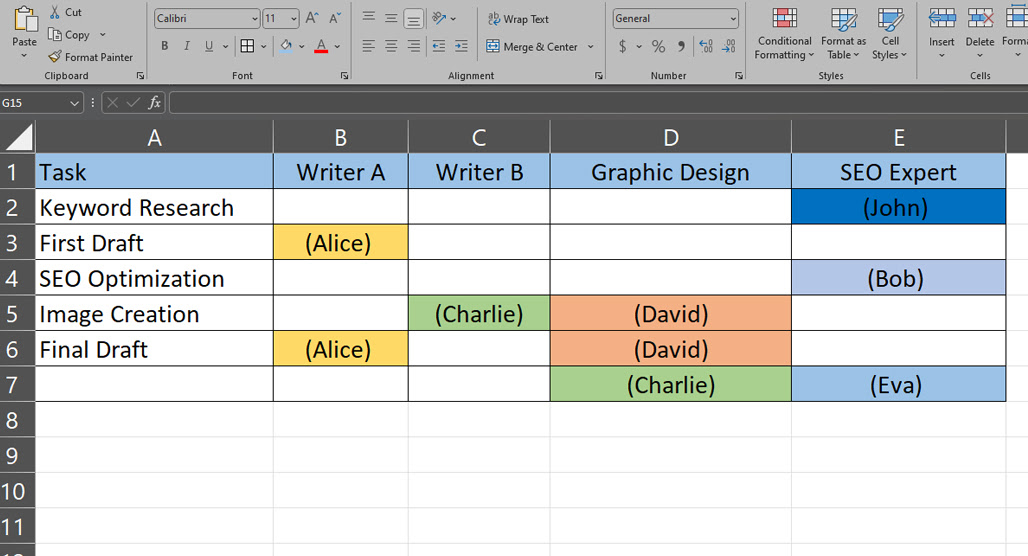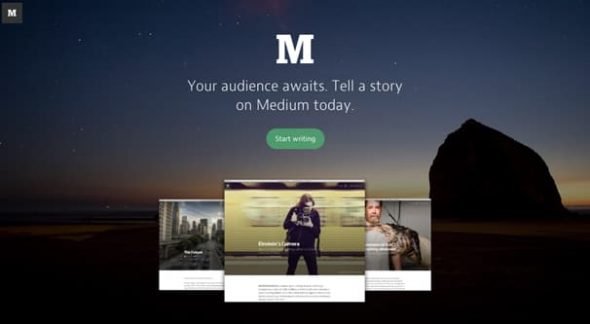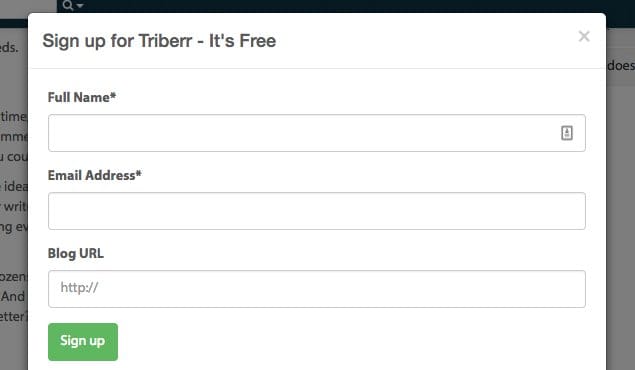What is a Content Roadmap and How Do You Create One?

When you’re creating a blog, do you just open up the WordPress “New Post” window and stare at a blinking cursor until something comes to mind?
Of course not – or at least, I hope not. You come at it with a plan. You have a keyword, a topic idea, and some idea of where you want the post to go. If you’re in it for business purposes, which my readers generally are, you probably also have other details in mind, like your target audience, buyer persona, and the search intent of the queries leading to your content.
That’s all great for producing a single piece of excellent content. I have a question, though: how do you produce it?
The best marketers aren’t just taking individual combinations of search intent, audience, and keywords and writing stream-of-consciousness as the mood strikes. Content is planned. A team is involved. There are deadlines, deliverables, schedules, and timelines. From topic ideation to publication, each step along the way needs to happen sequentially for the whole thing to come together.
What is a Content Roadmap?
A content roadmap is, in simple terms, a detailed document that outlines the full process from picking a topic to cover through producing content to the eventual publication.
Some roadmaps go beyond this and cover post-publication updates, refreshes, and promotion; others eschew that for other teams and focus the roadmap solely on the content production pipeline.
A content roadmap is visible. It’s available for everyone from your production team to your stakeholders. It’s clear in its expectations. It’s specific with deadlines. It’s a tool. It keeps your team working together smoothly and in a cohesive unit, so there are no bottlenecks, delays, or problems that send your production grinding to a halt.
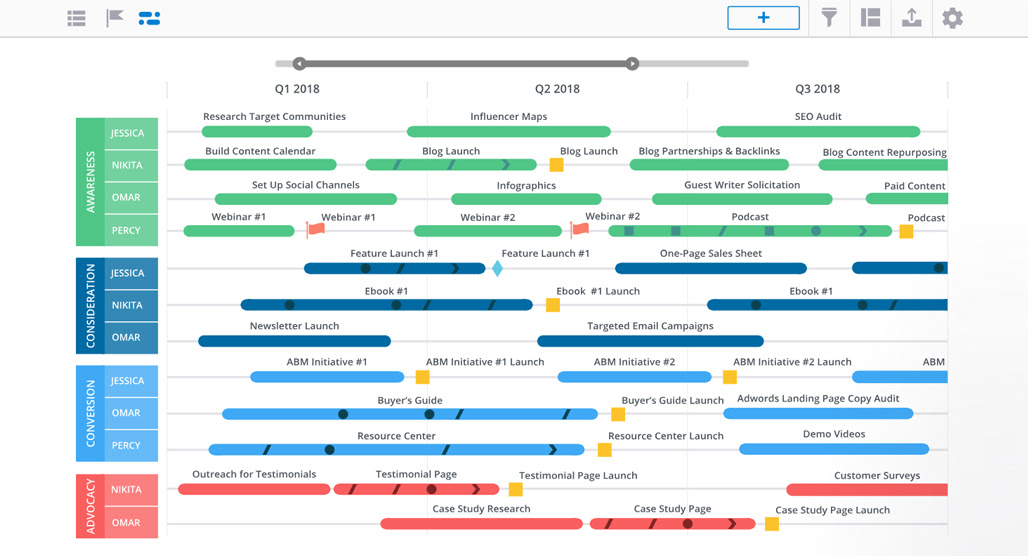
Image source: https://roadmunk.com/roadmap-templates/content-marketing-roadmap/
A good content roadmap can also be a form of validation. Your individual team members can see the progress their contributions are making, feel a tangible sense of progression, and know when the fruits of their labor are published.
So, how do you put together a content roadmap?
Step 1: Define the Overall Goal
A content roadmap starts with the end. What is the goal you’re working towards? This isn’t an abstract goal, a business goal, or even necessarily a SMART goal. It’s just the completion of whatever project you’re working on. Generally, your content roadmap will be one of two things:
- A roadmap to the publication of a piece of content.
- A roadmap to the publication of a campaign.
You can think of this in sort of the same terms you would PPC advertising. The first option is the creation of an individual ad, which has a bunch of steps required to reach it and perform it successfully and can be fine standing on its own. The second is the overall ad campaign, which encompasses many different ads and channels.
The only difference here is scope. The second one contains the first one in its entirety, replicated times however many pieces of content you’re publishing. Of course, it’s not as simple as a copy and paste; you can layer these things and integrate them in batches, with certain duplicate steps eliminated and deadlines lumped together.
For example, if you have a campaign you’re building towards the launch of a new product, you might decide you want to produce ten pieces of blog content to lead up to it. You’ll generally only do one large batch of topic research, but ten instances of the outline -> first draft -> revisions -> final draft -> polishing pipeline. Your graphics team will create some unique assets for each piece of content, but also a handful of shared assets that are reused between them for consistent branding and messaging.
Defining the goal is as simple as saying, “By X date, we will publish Y number of pieces of content on Z subject.” It might not sound complex, and it really isn’t; to use an analogy, it’s akin to picking the final destination of a road trip.
Step 2: Set Milestones for Progress
The second step is to break down the steps necessary to reach your overall goal. This is your high-level deliverables at each stage of the process. For a multi-content campaign, it includes each piece of content; for a single piece of content, it contains things like the research and guidelines packet, the first draft, the images, and the final draft.
How granular you make this depends on your overall scope. Your goal isn’t to break down every single individual step, though; you just want an overall, general outline of each major milestone. These may also be the significant milestones you can celebrate for larger campaigns. Things like “all first drafts produced” and “all content ready for publication” can be good milestones.
In general, you want your milestones to be things relevant to the whole team, not just to individuals. They’re meant to celebrate goals reached by the team and to track overall progress, not put pressure on individuals.
Step 3: Enumerate Tasks and Steps
Once your overall milestones are laid out, you can break down the individual tasks necessary to reach those milestones and the steps necessary to accomplish those tasks. For a simple blog post, you might have something that looks like this:
- Initial Research
- Topic Ideation
- Keyword Ideation
- Title Generation
- Brand Guidelines Development
- Style, Tone, and Aesthetic Guidelines Development
- Topic Resources Compilation
- Content Writing
- Outline Creation
- First Draft Production
- Overall Revision
- Second Draft Refinement
- Editing and Fact-Checking
- Final Draft Validation
- Media Creation
- Shared Asset Creation
- Individual Content Asset Creation
- SEO
- Link Insertion
- Meta Data Creation
- Keyword Optimization
- Publication
- Post Scheduling
- Final In Situ Review
- Post-Publication Check
- Promotion
This shows you the kind of framework you’ll be looking at. You can also see, for example, where some elements are one-time productions (like the initial research section) while others are per-content (the content writing section). How you break these down, how you layer them, and even how you outline them using project management apps, kanban boards, or other tools is entirely up to you. Every team will be different.
I’ve known businesses that do all of this through a couple of Slack channels and some assorted Google Docs, and I’ve known others that have elaborate setups using Asana or Trello and a variety of other cloud platforms or team-login CMS systems and more. The key isn’t to fit your team to a setup; it’s to configure a setup for your team.
I’ve also seen some recommendations of even greater detail in the breakdown of tasks. I don’t really think it’s useful, though; you end up just micromanaging tiny details where there’s no tangible benefit to even tracking them. You don’t need to make a writer deliver a blog post draft section by section, right? Maybe for a large eBook, but not a blog post.
Speaking of eBooks, a larger overall campaign can have more than just basic blog posts in it. For example, you might have a single massive core pillar post, 5-10 secondary major posts, a tie-in eBook, scripts for videos and podcasts, infographics, and more, all as part of the same campaign. All of these can be added to the content roadmap; it just makes it more complex and sets a priority order for certain tasks, which you’ll determine in the next step anyway.
Step 4: Map Dependencies
Dependencies are a huge part of where issues, roadblocks, and challenges crop up in this process. Some are obvious, of course; you can’t have a second draft in if your first draft hasn’t been produced yet. You can’t do keyword insertion and optimization without first having done the keyword research.
Your goal is to create a relational map between each element and task that needs to be accomplished. There are two reasons to do this.
- You can determine a balance of work for your team and learn which roles are going to be load-bearing for others.
- You can estimate the workload and deadlines for individual team members and, if necessary, consider adding team members to lighten the load.
A common stumbling block is an entire team that has to wait for one person who has expertise to use the SEO and research tools to develop all of the topic ideation and resources. Until that person is done, essentially, no other work can be completed.
Similarly, if you’re producing a bunch of different pieces of content and only have one writer, there’s only so much content they can produce in a given day or week, but other team members and other tasks have to wait for them to finish. Adding more writers can alleviate this burden – parallel versus serial production – but then, more team members mean more expense, and you risk losing some of your voice and tone cohesion. It’s a trade-off, in other words.
Note that there’s no one right answer here; different teams with different capabilities work better in different ways, and each method has pros and cons.
Step 5: Designate Deadlines
Next up is where you start nailing things down and coming up with your deadlines.
Usually, when you start this whole process, you have some idea of the overall deadline. That is the date at which this current project will be done, the product launch, the holiday you’re targeting, or another temporal milestone. Often, larger businesses will have these kinds of roadmaps developed monthly or per quarter. Some brands go from holiday to holiday. Again, this is personalized to your company and your projects.
Next involves a bit of math. Figure out how long, on average, it takes each task to be completed. Add a little time for leeway, and start building your dates. When, based on the average working pace of your team members, should each milestone be met? When, based on your editorial calendar, the holiday schedule, and your deadlines, should each phase of each process be completed?
You have your starting point and your ending point. You have your individual tasks, and you can easily arrange them in the order they need to be completed according to your dependency map. Assigning dates for deadlines for each shouldn’t be too much of a reach.
There are two common issues you might run into here.
The first is bottlenecks. You ideally catch this in your dependency mapping, but you might not realize until you start setting dates that there are a lot of overlapping responsibilities. This might not be a bad thing if you have a star employee who can handle it (and then take a nap), but you do always have to be aware of the possibility of catastrophe. If your single load-bearing employee gets sick, is in a car accident, or has a family emergency, how do you handle it?
The second is deadlines that are much too tight. Your team has a capacity, and it’s not necessarily a bad thing to push that capacity from time to time, but the longer it lasts and the more pressure it causes, the worse it becomes for everyone involved. Right now, the entertainment industry is a prime example of this, with “crunch” and burnout reaching a breaking point.
Step 6: Assign Contributors
Ideally, at this point, you have a pretty good idea of who you want to be performing each task. In some cases, you might not even have a choice; if you have one writer, one graphics design person, and one SEO expert, you’re kind of locked in. For larger teams, though, you start to assign who does what. This may even be very specific; if you have a project where you’re making ten blog posts and you have three writers, you decide which specific posts go to which writers here. Or, certainly, you can just open up the list and let the writers organize who gets what according to their specialties and interests. Again, whatever works for your team.
At this point, you have everything on your roadmap planned and ready to go.
Step 7: Track Progress and Celebrate Milestones
All that’s left is to put your roadmap into action. Publish the roadmap where anyone with a stake in the project can see it, assign individuals to tasks on your project management app if necessary, and get the ball rolling. Track progress along the way and, when major milestones are reached, celebrate them with the team.
As you go, unexpected issues will come up. Some are one-time issues you need to solve, adapt, and move past; others might be structural and are reasons to re-evaluate your roadmap. Take those issues into consideration, adapt as best you can, and work them into your next roadmap. Over time, you’ll have a cohesive team that works well together, a keen understanding of the timing and capacity of said team, and a refined roadmap that can help you get things done effectively.
Leave a Comment
Fine-tuned for competitive creators
Topicfinder is designed by a content marketing agency that writes hundreds of longform articles every month and competes at the highest level. It’s tailor-built for competitive content teams, marketers, and businesses.
Get Started

